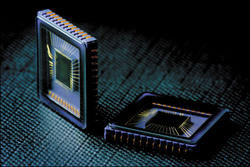| Posted: January 15, 2007 |
Nanotechnology imaging sensor gets rid of flash in cameras |
|
(Nanowerk News) A Korean company was demonstrating its new nanotechnology-based Single Carrier Modulation Photo Detector (SMPD) at last week's Consumer Electronics Show. The company says the sensor is 2,000 times more sensitive to light than traditional photo sensors – it can take picture in near total darkness.
|
|
Until now, taking a picture in the dark without a flash or taking a picture of a candle-lit birthday cake without any other light in the room would yield a dark photograph. The new sensor makes it possible to take clear images even when the light level is less than 1 lux (or up to 0.1 lux). One lux is equivalent to the brightness from one candle one meter away in a dark room. Human eyes can barely distinguish images at less than 1 lux.
|
 |
|
"The SMPD image sensor will change how professional and amateur photographers and videographers capture images and video," said Dr. Hoon Kim, chief technology officer for Planet82, the sensor's manufacturer and director of the Nano Scale Quantum Devices Research Center at the Korea Electronics Technology Institute (KETI). "By replacing flash with the SMPD's slim design, manufacturers can produce next-generation electronics that offer higher image quality, energy efficiency and cost-savings regardless of light conditions and without the distortion or battery drain of a flash."
|
|
Unlike photodiode-based CMOS and CCD technologies, which require millions of photoelectrons per pixel unit to create an image, the SMPD is able to react to tiny amounts of photons in light levels less than 1lux, said the company, and the SMPD's high sensitivity to light enables it to outperform CCD- and CMOS-based devices, enabling it to sense light wavelengths into the infrared band. In addition, the SMPD's unique pixel structure increases its dynamic range so that it is highly sensitive, up to 3.5 x 104V/lux-s, enabling it to capture low-light pictures at higher frame rates of 30fps. Power consumption is 82mW at 30fps. The maximum dynamic range is 120dB.
|
|
The SMPD image sensor can be mass-produced using standard CMOS process without additional investment for facilities. It is half the size of the current CCD image sensor used in digital cameras and closed circuit television cameras (CCTVs), and CMOS image sensors used in camera phones. Additionally, digital cameras and camera phones have low sensitivity to dim light, therefore making it difficult to take a picture in the dark without a flash.
|
|
The company expects SMPD image sensor will firstly be available in CCTVs, camera phones and vehicle rear-view sensors. The SMPD technology also makes it ideally suited for applications in healthcare, the military, environmental industries and more, as well as electrical appliances such as digital cameras or camcorders.
|

